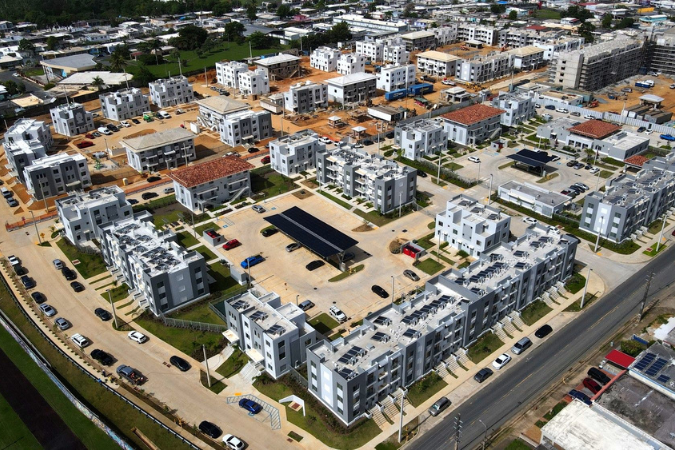3 Ways to Safeguard Your Site Against Natural Disasters
Written By AD&V®ABOUT THE AUTHOR | AD&V® is dedicated to advanced and energy-efficient sustainable architecture & interior design that enhances people’s experience of the world and improves their lives.
CLIMATE CHANGE CAN BE FACED BY TAKING A COMPREHENSIVE APPROACH TO CONSTRUCTION AND HABITATION.
This includes safeguarding your property from destruction and managing water including precipitation, flooding, stormwater runoff, storm surge, coastal erosion, or subsidence. An effective way to do this is to choose a safe location for site housing and integrate green and gray infrastructure components.
Here are some ways you can reinforce your site against natural disasters:
1. CHOOSE A SAFE LOCATION FOR SITE HOUSING
To safeguard your site against natural disasters it’s important to select a site that’s located in an area that can keep you protected from natural disasters. If you’re going to choose a site to build on, avoid selecting one in FEMA-designated floodplains or floodways since they can be prone to landslides. You can also consult resources such as the Keep Safe Guide for Resilient Housing Design in Island Communities to identify sites where natural hazards are likely.
To prevent water from affecting neighboring properties, ensure proper drainage paths from the roof, down the walls, away from the house and site, and into street gutters. In arid areas, make sure that a water supply is available to maintain healthy vegetation and prevent fire hazards. Coastal areas are not recommended for locating homes, buildings, or associated infrastructure.
Choosing a safe location for site housing is dependent primarily on how it responds to nature’s elements.
2. IMPLEMENT GREEN INFRASTRUCTURE ON SITE
Nature-based solutions to site fortification are employed through green infrastructure. Green infrastructure is an approach to water management that protects, restores, or mimics the natural water cycle. It’s best to consult contractors, civil engineers, agronomists, or the Agricultural Extension Service (SEA) to design green infrastructure systems. Green infrastructure on site can be:
Berms: Compacted ridges that slow water flow, prevent erosion, and provide additional recreational areas.
Swales: Shallow channels with sloped sides that manage water runoff, filter pollutants, and direct water to gardens or buried dry wells for absorption. Artificial swales often serve as infiltration basins.
Bio Swales/Rain Gardens: Designed to receive and filter water through underground layers and vegetation, aiding in rainwater absorption. They can be tailored to handle specific rainfall amounts.
Boulders: Strategically placed large rocks to control water flow, retain soil, and mitigate erosion.
Vegetation: Planting vegetation anchors soil, mitigates flooding, and stabilizes the site.
Green Roofs: Partially or fully covered roofs with soil, plants, and a waterproofing membrane. Consult an architect or structural engineer to assess weight-bearing capacity.
Ridges: Large rocks placed strategically to direct water, stabilize soil, and minimize erosion.
Fire-Wise Housing: Strategically position non-flammable plants and objects around your property.
Dunes: Coastal sand mounds with vegetation that provide protection against coastal hazards and serve as a sand source for beach replenishment.
Overall, green infrastructure offers numerous benefits, including improved water management, enhanced climate resilience, increased biodiversity, reduced energy consumption, and improved quality of life for communities.
3. IMPLEMENT GRAY INFRASTRUCTURE ON SITE
To control flooding risks, gray infrastructure utilizes constructed elements such as sewers, pipes, dams, and drainage ditches. Gray infrastructure may require special permits and a specialized professional team and can be costlier and more disruptive if not correctly designed and built. To design gray infrastructure systems, contact professionals such as contractors, civil engineers, agronomists, or the Agricultural Extension Service (SEA). Below are some examples of gray infrastructure:
Retaining Walls: Permanent barriers that prevent water infiltration and stabilize steep slopes, protecting critical infrastructure.
Dry Wells: Underground tanks, often made of concrete, that store and gradually drain water to another location or sewer.
French Drain: A system that slowly drains surface water using a perforated PVC tube or rocks, allowing water to percolate through the soil.
Ditch: Channels used to redirect water flow.
Permeable Surfaces: Pavers, porous concrete, or other flooring systems that facilitate slow water percolation into the soil instead of impervious pavement.
Gray infrastructure plays a crucial role in supporting urban development and meeting the needs of growing populations. It provides essential services such as clean water supply, sanitation, transportation, and energy distribution.
FORTIFY YOUR SITE RIGHT
Site fortification is a crucial aspect of disaster preparedness. Risks threatening sites prone to flooding and fire can be mitigated by designing green and gray infrastructures to work together. Integrating gray and green infrastructure solutions can help achieve more sustainable and resilient urban systems. By implementing fortification strategies, you can protect sites and communities despite devastating natural disasters.
FURTHER READING: 6 WAYS TO ASSESS YOUR HOME BEFORE A NATURAL DISASTER




